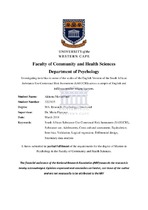| dc.contributor.advisor | Florence, Maria | |
| dc.contributor.author | Nkwanyana, Akhona | |
| dc.date.accessioned | 2018-08-02T10:52:10Z | |
| dc.date.available | 2018-08-02T10:52:10Z | |
| dc.date.issued | 2018 | |
| dc.identifier.uri | http://hdl.handle.net/11394/6178 | |
| dc.description | Magister Psychologiae - MPsych (Psychology) | |
| dc.description.abstract | Substance abuse is a global concern, particularly amongst adolescents. Research shows that
secondary school learners in the Western Cape are susceptible to substance use due to the
ease of access to and constant use of drugs and alcohol by their peers. The use of substances
by adolescents has been linked to a number of negative consequences. The South African
Substance Use Contextual Risk Instrument (SASUCRI) is an instrument developed for the
purpose of identifying factors that lead to adolescent substance use and communities at risk
of substance abuse. In the identification of these factors, appropriate interventions can be
informed in terms of the areas that need to be focused on when dealing with the reduction of
substance use. Two versions of the SASUCRI exist. However, in the investigation of the
larger validation study, IsiXhosa mother-tongue learners were found to have responded to the
English version of the SASUCRI. A sub-study to the larger study found that certain scales of
the English version of the SASUCRI proved to be in-equivalent across the English and
isiXhosa mother-tongue speakers. Recommendations were made for a further validation of
the instrument by investigating the level of item bias within the in-equivalent scales, to
determine the extent to which it measures what it was intended to measure. Using secondary
data from the larger study, the current study investigated item bias on the identified inequivalent
scales of the English version of the SASUCRI across the two language groups,
using a differential research design and two statistical techniques (Mantel-Haenszel and
logistic regression). The theoretical framework was that of Bias and Equivalence. Permission
to conduct the study and use the data was granted from various institutions and people: the
Western Cape Education Department and school principals, Committees at UWC, and the
researcher of the larger study. Results revealed that bias was found in some of these scales
which limit its ability to be used for its intended purpose. Therefore, recommendations for the
adaptation of the English version were made. | |
| dc.language.iso | en | |
| dc.publisher | University of the Western Cape | |
| dc.subject | South African Substance Use Contextual Risk Instrument (SASUCRI) | |
| dc.subject | Substance use | |
| dc.subject | Adolescents | |
| dc.subject | Cross-cultural assessment | |
| dc.subject | Mother tongue education | |
| dc.subject | isiXhosa | |
| dc.subject | English | |
| dc.title | Investigating item bias in some of the scales of the English version of the South African Substance Use Contextual Risk Instrument (SASUCRI) across a sample of English and isiXhosa mother-tongue learners | |
| dc.rights.holder | University of the Western Cape | |

